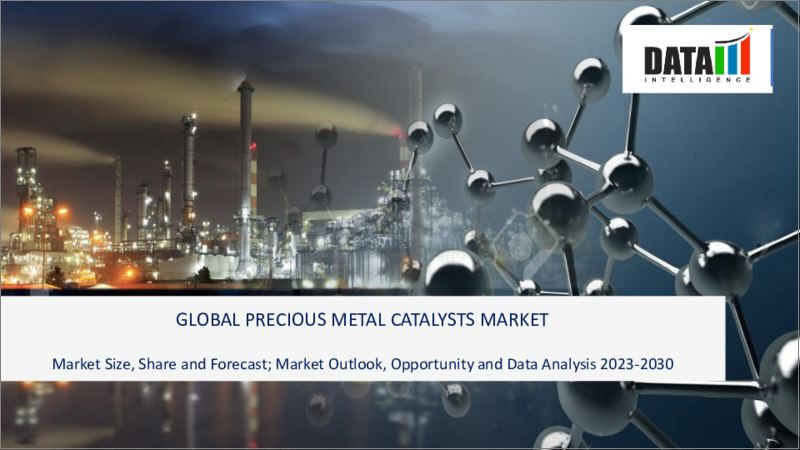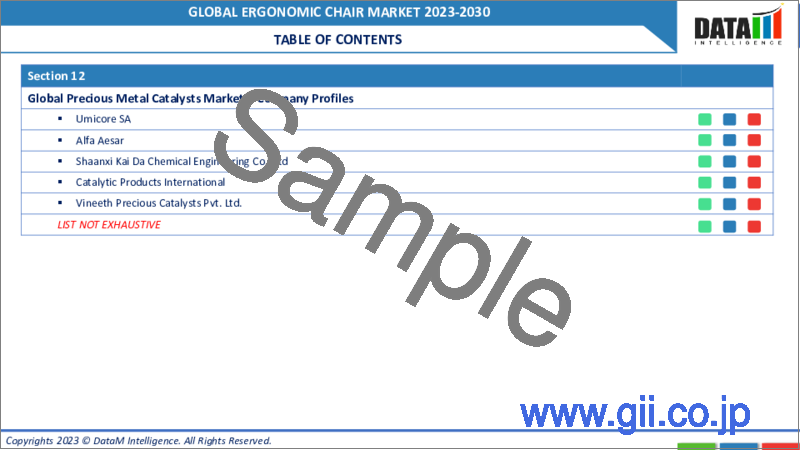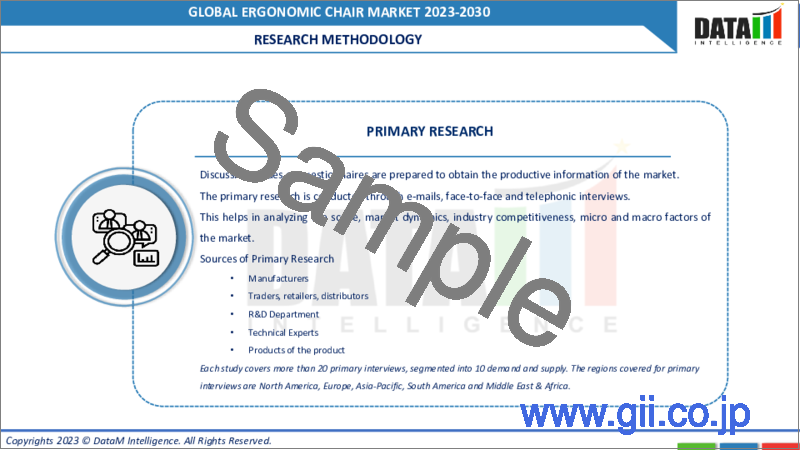|
|
市場調査レポート
商品コード
1290364
貴金属触媒の世界市場-2023-2030Global Precious Metal Catalysts Market - 2023-2030 |
||||||
カスタマイズ可能
適宜更新あり
|
|||||||
| 貴金属触媒の世界市場-2023-2030 |
|
出版日: 2023年06月12日
発行: DataM Intelligence
ページ情報: 英文 188 Pages
納期: 即日から翌営業日
|
- 全表示
- 概要
- 目次
市場概要
貴金属触媒の世界市場規模は、2022年に191億米ドルに達し、2023年から2030年にかけてCAGR5.8%で成長し、2030年には299億米ドルに達すると予想されています。
2023年3月28日、インドのムンバイに近いドンビブリの製造施設において、エボニック触媒は、KALCATおよびMetalystブランドで販売する活性ニッケル粉末触媒の生産能力を完全に向上させる予定です。多目的生産設備の世界ネットワークは、総投資額一桁万ユーロのデボトルネッキングプロジェクトを予定通りに完了し、エボニックの生産能力を25%向上させる見込みです。
これらの設備により、生産性の向上、インフラの強化、生産能力のさらなる強化が図られます。2024年後半には、市場が新しい生産能力を使用できるようになると予想されます。したがって、インドは2022年の地域別市場シェアの1/3以上を占め、予測期間中に大きなCAGRで成長すると予想されます。
市場力学
研究開発投資の拡大
研究開発投資により、触媒活性、選択性、失活耐性が強化された新規触媒の開発が可能になります。研究者は、性能を向上させるために、新しい合成方法、担体材料、触媒の設計を模索しています。
例えば、異なる貴金属を組み合わせたバイメタル触媒や合金触媒を使用することで、相乗効果や触媒特性の向上が期待できます。また、研究開発努力により、高い触媒効率と安定性を示す担持ナノ粒子など、構造が明確に定義された不均一系触媒が開発されています。
研究開発投資は、新しいアプリケーションや触媒プロセスの探求を促進し、貴金属触媒のマーケットポテンシャルを拡大します。研究者は、貴金属触媒のユニークな特性を生かすことができる新しい反応や触媒システムを調査しています。例えば、再生可能エネルギー、バイオマス変換、炭素回収・利用などの新しい分野で、研究開発の努力によって貴金属触媒が使用されるようになりました。応用範囲を広げることで、研究開発投資は新たな市場機会を開拓し、貴金属触媒市場の成長を促進します。
触媒材料における継続的な技術的進歩
貴金属触媒の活性、選択性、安定性など、触媒性能の向上に焦点を当てた技術的進歩が行われています。研究者は、従来の触媒に比べて高い触媒効率と改善された性能を示す新規材料と触媒処方を探求し、それが貴金属触媒の世界市場を牽引しています。
例えば、ナノ粒子合成と表面工学の進歩により、表面積が増加し、触媒活性が向上した高分散触媒や担持触媒が開発されています。
さらに、貴金属触媒のシンタリング、被毒、溶出などの不活性化メカニズムに対する耐久性と耐性を向上させることにも焦点が当てられています。研究開発者は、過酷な反応条件下で安定性を向上させる材料や触媒の配合を開発しています。
したがって、触媒材料の継続的な技術進歩は、触媒性能の向上、貴金属の効率的な使用、耐久性と耐性、新規材料の探索、高度な特性評価技術の活用によって、世界の貴金属触媒市場の成長に寄与しています。
貴金属の高コストと限られた入手可能性
触媒に使用される貴金属は有限の資源であり、その入手可能性は鉱山の生産、地政学的要因、市場力学に左右されます。供給の途絶、地政学的緊張、需要の変動は、貴金属の入手可能性と価格に影響を与え、市場の変動につながる可能性があります。
メーカーは、触媒性能を維持しながら必要な貴金属の量を減らすために、触媒処方の最適化に注力しています。メーカーは、使用済み触媒からの貴金属のリサイクルと回収を可能にする技術に投資しており、一次採掘情報への依存を減らし、高コストの影響を緩和しています。
入手可能な量が限られていると、サプライチェーンに不確実性が生じ、世界の貴金属触媒市場の成長を阻害する可能性があります。メーカーは研究開発に投資し、豊富で容易に入手可能な代替触媒材料を探索することで、貴金属への依存度を下げています。メーカーは、貴金属の利用率を最大化する触媒プロセスの開発に取り組み、効率を向上させ、これらの限られた資源の需要を減らしています。
COVID-19の影響分析
パンデミックにまつわる不確実性は、触媒によく使われるプラチナ、パラジウム、ロジウムを含む貴金属の価格に変動をもたらしました。価格の変動は、メーカーと消費者の双方にとって、効果的な計画と予算を立てることを困難にしました。例えば、自動車の排ガス規制に不可欠な触媒金属であるパラジウムの価格は、パンデミック中に大きく変動しました。
OICA(世界自動車工業会)は、2019年第3四半期と2020年第3四半期に、それぞれ世界で5,000万台と6,500万台の自動車が生産されると予測しています。COVID-19の上昇が生産量減少の原因となっています。
一方、戸締まりや輸送規制が減ると、自動車産業は復活する可能性が高かったです。また、製薬業界も正常に機能し始めたため、予測期間中、貴金属触媒の需要は増加すると思われます。
ロシア・ウクライナ紛争影響分析
紛争を受け、貴金属触媒のメーカーと消費者は、リスクを軽減するために代替供給源を探すかもしれないです。サプライチェーンを多様化し、紛争の影響を受ける地域への依存度を下げるためのオプションを検討する可能性があります。このような供給源の変化は、貿易パターンと市場力学の変化につながり、貴金属触媒の価格と入手可能性に影響を与える可能性があります。
また、ロシア・ウクライナ紛争は、貴金属触媒に大きく依存する産業にも間接的な影響を及ぼしています。例えば、排ガス規制用触媒の主要な消費者である自動車産業は、紛争が貴金属の供給と価格に影響を与えた場合、混乱が生じる可能性があります。このような混乱は、自動車の生産と入手に影響を与え、サプライチェーン全体に波及する可能性があります。
人工知能の影響分析
AIは、より持続可能な触媒技術の開発に貢献することができます。AI技術を活用することで、研究者は代替触媒材料の探索、選択性と耐久性を高めた触媒の設計、エネルギー消費と廃棄物の発生を抑えるための反応条件の最適化などが可能になります。これは、持続可能な製造方法への世界のシフトと、環境に優しい触媒ソリューションの需要に合致しています。
したがって、AIは、触媒開拓の加速、製造プロセスの最適化、品質管理の向上、需要予測の促進、サプライチェーン業務の合理化、持続可能性の推進によって、世界の貴金属触媒市場を変革する可能性を秘めています。この分野でAI技術を採用することで、大幅なコスト削減、製品性能の向上、触媒の生産と使用に対するより環境に配慮したアプローチを実現することができます。
目次
第1章 調査手法とスコープ
- 調査手法
- 調査目的および調査範囲
第2章 定義と概要
第3章 エグゼクティブサマリー
- タイプ別市場内訳
- 市場内訳:アプリケーション別
- 市場内訳:地域別
第4章 市場力学
- 影響要因
- 促進要因
- 研究開発投資の拡大
- 触媒材料における継続的な技術的進歩
- 抑制要因
- 貴金属のコスト高と入手の困難さ
- 機会
- 影響分析
- 促進要因
第5章 産業分析
- ポーターのファイブフォース分析
- サプライチェーン分析
- 価格分析
- 法規制の分析
第6章 COVID-19の分析
- COVID-19の分析
- COVID前のシナリオ
- COVID中のシナリオ
- COVID後のシナリオ
- COVID実施中の価格ダイナミクス
- 需給スペクトル
- パンデミック時の市場に関連する政府の取り組み
- メーカーの戦略的な取り組み
- サマリー
第7章 タイプ別
- タイプ別市場材料分析および前年比成長率分析(%):タイプ別
- プラチナ
- 市場材料の分析と前年比成長率分析(%)
- パラジウム
- ロジウム
- ルテニウム
- イリジウム
第8章 アプリケーション別
- 用途別市場材料分析および前年比成長率分析(%):用途別
- 自動車用
- 市場材料の分析とYo-Y成長分析(%)
- 製油所
- 製薬
- その他
第9章 地域別
- 市場材料の分析とYo-Y成長分析(%)(地域別
- 北米
- 市場材料の分析とYo-Y成長率分析(%):タイプ別
- 市場材料の分析とYo-Y成長分析(%)、用途別
- 市場材料の分析とYoY成長分析(%):国別
- 米国
- カナダ
- メキシコ
- 欧州
- 市場材料の分析とYoY成長分析(%)、タイプ別
- 市場材料の分析とYoY成長分析(%):用途別
- 市場材料の分析とYoY成長分析(%)、:国別
- ドイツ
- 英国
- フランス
- イタリア
- ロシア
- その他欧州
- 南米
- 市場材料の分析とYoY成長分析(%):タイプ別
- 市場材料の分析とYoY成長分析(%)、用途別
- 市場材料の分析とYoY成長分析(%)、:国別
- ブラジル
- アルゼンチン
- その他南米地域
- アジア太平洋地域
- 市場材料の分析とYoY成長分析(%)、タイプ別
- 市場材料の分析とYoY成長分析(%)、用途別
- 市場材料の分析とYoY成長分析(%)、:国別
- 中国
- インド
- 日本
- オーストラリア
- その他アジア太平洋地域
- 中東・アフリカ地域
- 市場材料分析および前年比成長率分析:タイプ別
- 市場材料分析および前年比成長率分析(%):用途別
第10章 競合情勢
- 競合シナリオ
- 市況/シェア分析
- M&A(合併・買収)分析
第11章 企業プロファイル
- BASF SE
- 会社概要
- 製品ポートフォリオと説明
- 財務概要
- 主な発展状況
- Evonik Industries AG
- Johnson Matthey PLC
- Heraeus Group
- Clariant Global Ltd
- Umicore SA
- Alfa Aesar
- Shaanxi Kai Da Chemical Engineering Co., Ltd
- Catalytic Products Global
- Vineeth Precious Catalysts Pvt. Ltd.
第12章 付録
Market Overview
The Global Precious Metal Catalysts Market size reached US$ 19.1 billion in 2022 and is expected to reach US$ 29.9 billion by 2030 growing at a CAGR of 5.8% during the forecast period 2023-2030.
On March 28, 2023, At its manufacturing facility in Dombivli, close to Mumbai, India, Evonik Catalysts is completely on track to increase its production capabilities for activated nickel powder catalysts sold under the KALCAT and Metalyst brands. A global network of multipurpose production facilities is expected to complete the debottlenecking projects, with a total investment of high single-digit million Euros, on schedule and to increase Evonik's capacity by 25%.
These facilities will increase productivity, enhance infrastructure and further strengthen production capabilities. In the second half of 2024, the market is anticipated to be able to use the new capacity. Therefore, India accounted for more than 1/3rd of the regional market shares in 2022 and is expected to grow at a significant CAGR during the forecasted period.
Market Dynamics
Growing Research and Development Investments
R&D investment enables the development of novel catalyst formulations that offer enhanced catalytic activity, selectivity and resistance to deactivation. Researchers explore new synthesis methods, support materials and catalyst designs to improve performance.
For instance, the use of bimetallic or alloyed catalysts combining different precious metals can result in synergistic effects and improved catalytic properties. R&D efforts have also led to the development of heterogeneous catalysts with well-defined structures, such as supported nanoparticles, which exhibit high catalytic efficiency and stability.
R&D investment drives the exploration of new applications and catalytic processes, expanding the market potential for precious metal catalysts. Researchers investigate novel reactions and catalytic systems that can benefit from the unique properties of precious metal catalysts. For example, R&D efforts have led to the use of precious metal catalysts in emerging fields such as renewable energy, biomass conversion and carbon capture and utilization. By expanding the range of applications, R&D investment opens up new market opportunities and drives the growth of the precious metal catalysts market.
Ongoing Technological Advancements in Catalyst Materials
Technological advancements focus on enhancing the catalytic performance of precious metal catalysts, including their activity, selectivity and stability. Researchers explore novel materials and catalyst formulations that exhibit higher catalytic efficiency and improved performance compared to traditional catalysts, which in turn drives the global precious metal catalysts market.
For example, advancements in nanoparticle synthesis and surface engineering have led to the development of highly dispersed and supported catalysts with increased surface area, enhancing catalytic activity.
Ongoing advancements focus on improving the durability and resistance of precious metal catalysts against deactivation mechanisms such as sintering, poisoning and leaching. Researchers develop materials and catalyst formulations that exhibit enhanced stability under harsh reaction conditions.
Therefore, ongoing technological advancements in catalyst materials contribute to the growth of the global precious metal catalysts market by improving catalytic performance, efficient use of precious metals, durability and resistance, exploring novel materials and utilizing advanced characterization techniques.
Higher Cost and Limited Availability of Precious Metals
Precious metals used in catalysts are finite resources and their availability is subject to mining production, geopolitical factors and market dynamics. Supply disruptions, geopolitical tensions and fluctuations in demand can affect the availability and pricing of precious metals, leading to volatility in the market.
Manufacturers are focused on optimizing catalyst formulations to reduce the amount of precious metals required while maintaining catalytic performance. Manufacturers are investing in technologies that enable the recycling and recovery of precious metals from spent catalysts, reducing the reliance on primary mining sources and mitigating the impact of high costs.
Limited availability can create uncertainties in the supply chain and hinder the growth of the global precious metal catalysts market. Manufacturers are investing in research and development to explore alternative catalyst materials that are abundant and readily available, reducing dependence on precious metals. Manufacturers are working on developing catalytic processes that maximize the utilization of precious metals, improving efficiency and reducing the demand for these limited resources.
COVID-19 Impact Analysis
The uncertainty surrounding the pandemic created volatility in precious metal prices, including those of platinum, palladium and rhodium, which are commonly used in catalysts. The fluctuating prices made it difficult for both manufacturers and consumers to plan and budget effectively. For example, the price of palladium, a crucial catalyst metal for automotive emissions control, experienced significant swings during the pandemic.
The OICA (Global Organisation of Motor Vehicle Manufacturers) estimates that in the third quarters of 2019 and 2020, respectively, the world produced 50 million and 65 million automobiles. The rise in COVID-19 is to blame for the decline in output.
On the other hand, as lockdown and transportation regulations decrease, the automotive industry were likely to revive. Additionally, the pharmaceutical industry has started to function normally again, which will probably increase demand for precious metal catalysts throughout the forecast period.
Russia-Ukraine War Impact Analysis
In response to the conflict, manufacturers and consumers of precious metal catalysts may seek alternative supply sources to mitigate risks. They may explore options to diversify their supply chains and reduce dependency on regions affected by the conflict. This shift in supply sources can lead to changes in trade patterns and market dynamics, potentially affecting prices and the availability of precious metal catalysts.
The Russia-Ukraine conflict has also had indirect impacts on industries that heavily rely on precious metal catalysts. For example, the automotive industry, a major consumer of catalysts for emissions control, may experience disruptions if the conflict affects the supply and prices of precious metals. Such disruptions can impact the production and availability of vehicles, leading to ripple effects throughout the supply chain.
Artificial Intelligence Impact Analysis
AI can contribute to the development of more sustainable catalyst technologies. By leveraging AI techniques, researchers can explore alternative catalyst materials, design catalysts with enhanced selectivity and durability and optimize reaction conditions for reduced energy consumption and waste generation. This aligns with the global shift towards sustainable manufacturing practices and the demand for eco-friendly catalyst solutions.
Therefore, AI has the potential to revolutionize the global precious metal catalysts market by accelerating catalyst development, optimizing manufacturing processes, improving quality control, facilitating demand forecasting, streamlining supply chain operations and driving sustainability. Adopting AI technologies in this sector can lead to significant cost savings, improved product performance and a more environmentally conscious approach to catalyst production and usage.
Segment Analysis
The global precious metal catalysts market is segmented based on type, application and region.
Minimization of CO2 Emissions and Auto-Catalysts for Emission Reduction, Drives Platinum Growth
Platinum-based auto-catalysts facilitate the conversion of harmful gases, such as nitrogen oxides (NOx), carbon monoxide (CO) and volatile organic compounds (VOCs), into less harmful substances. For example, in gasoline engines, platinum catalysts help convert harmful nitrogen oxides into nitrogen and oxygen through a process called selective catalytic reduction.
Auto-catalysts help to lower emissions from petrol and diesel engines as well as increase the energy efficiency of industrial processes. The most effective way to reduce pollution from a variety of petrol and diesel vehicles has been using autocatalysts comprised of platinum group metals for more than 35 years.
The typical family car would produce 15 tons of harmful pollutants over the course of its 10-year lifespan if autocatalysts weren't present. Additionally, iridium is the second largest segment in the global precious metal catalyst market, acquiring nearly 1/4th of the global segmental share.
Geographical Analysis
Robust Growth in China's Industrial Applications
China has been actively transitioning towards cleaner and more sustainable energy sources. The country is investing heavily in renewable energy, such as wind and solar power and is the largest market for electric vehicles.
Precious metal catalysts are integral to technologies like fuel cells, which are crucial for clean energy generation and storage. China's focus on clean energy initiatives has increased the demand for precious metal catalysts in fuel cell applications.
However, as of March 2020, China lifted its lockdown and started several industrial operations, while other countries continue to impose lockdowns and restrictions on the industry.
According to the China Association of Automobile Manufacturers (CAAM) and the Centre of Policy Studies for the Automobile Industry in China (CPSAIC), China's automotive sales would total 27.2 million units in 2021, with 22.9 million personal cars (PVs) and 4.3 million commercial vehicles (CVs).
Therefore, it has been accounting for more than half of the regional market share in 2022 and is expected to grow at the highest CAGR during the forecasted period in the region.
Competitive Landscape
The major global players include: Angus Fire, Albilad Fighting Systems Ltd, Johnson Controls, Kerr Fire, Loshareh Chemical Industries, National Foam, Pgisystems, SFFECO Global, Shanghai Waysmos Fire Suppression Co. Ltd and Solberg.
Why Purchase the Report?
- To visualize the global precious metal catalysts market segmentation based on type, application and region, as well as understand key commercial assets and players.
- Identify commercial opportunities by analyzing trends and co-development.
- Excel data sheet with numerous data points of precious metal catalysts market level with all segments.
- PDF report consists of a comprehensive analysis after exhaustive qualitative interviews and an in-depth study.
- Product mapping available as Excel consisting of key products of all the major players.
The Global Precious Metal Catalysts Market Report Would Provide Approximately 53 Tables, 50 Figures and 188 Pages.
Target Audience 2023
- Manufacturers / Buyers
- Industry Investors/Investment Bankers
- Research Professionals
- Emerging Companies
Table of Contents
1. Methodology and Scope
- 1.1. Research Methodology
- 1.2. Research Objective and Scope of the Report
2. Definition and Overview
3. Executive Summary
- 3.1. Market Snippet by Type
- 3.2. Market Snippet by Application
- 3.3. Market Snippet by Region
4. Dynamics
- 4.1. Impacting Factors
- 4.1.1. Drivers
- 4.1.1.1. Growing Research and Development Investment
- 4.1.1.2. Ongoing Technological Advancements in Catalyst Materials
- 4.1.2. Restraints
- 4.1.2.1. Higher Cost and Limited Availability of Precious Metals
- 4.1.3. Opportunity
- 4.1.4. Impact Analysis
- 4.1.1. Drivers
5. Industry Analysis
- 5.1. Porter's Five Force Analysis
- 5.2. Supply Chain Analysis
- 5.3. Pricing Analysis
- 5.4. Regulatory Analysis
6. COVID-19 Analysis
- 6.1. Analysis of COVID-19
- 6.1.1. Scenario Before COVID
- 6.1.2. Scenario During COVID
- 6.1.3. Scenario Post COVID
- 6.2. Pricing Dynamics Amid COVID
- 6.3. Demand-Supply Spectrum
- 6.4. Government Initiatives Related to the Market During the Pandemic
- 6.5. Manufacturers' Strategic Initiatives
- 6.6. Conclusion
7. By Type
- 7.1. Introduction
- 7.1.1. Market Material Analysis and Y-o-Y Growth Analysis (%), By Type
- 7.1.2. Market Attractiveness Index, By Type
- 7.2. Platinum*
- 7.2.1. Introduction
- 7.2.2. Market Material Analysis and Y-o-Y Growth Analysis (%)
- 7.3. Palladium
- 7.4. Rhodium
- 7.5. Ruthenium
- 7.6. Iridium
8. By Application
- 8.1. Introduction
- 8.1.1. Market Material Analysis and Y-o-Y Growth Analysis (%), By Application
- 8.1.2. Market Attractiveness Index, By Application
- 8.2. Automotive*
- 8.2.1. Introduction
- 8.2.2. Market Material Analysis and Y-o-Y Growth Analysis (%)
- 8.3. Refinery
- 8.4. Pharmaceuticals
- 8.5. Others
9. By Region
- 9.1. Introduction
- 9.1.1. Market Material Analysis and Y-o-Y Growth Analysis (%), By Region
- 9.1.2. Market Attractiveness Index, By Region
- 9.2. North America
- 9.2.1. Introduction
- 9.2.2. Key Region-Specific Dynamics
- 9.2.3. Market Material Analysis and Y-o-Y Growth Analysis (%), By Type
- 9.2.4. Market Material Analysis and Y-o-Y Growth Analysis (%), By Application
- 9.2.5. Market Material Analysis and Y-o-Y Growth Analysis (%), By Country
- 9.2.5.1. The U.S.
- 9.2.5.2. Canada
- 9.2.5.3. Mexico
- 9.3. Europe
- 9.3.1. Introduction
- 9.3.2. Key Region-Specific Dynamics
- 9.3.3. Market Material Analysis and Y-o-Y Growth Analysis (%), By Type
- 9.3.4. Market Material Analysis and Y-o-Y Growth Analysis (%), By Application
- 9.3.5. Market Material Analysis and Y-o-Y Growth Analysis (%), By Country
- 9.3.5.1. Germany
- 9.3.5.2. UK
- 9.3.5.3. France
- 9.3.5.4. Italy
- 9.3.5.5. Russia
- 9.3.5.6. Rest of Europe
- 9.4. South America
- 9.4.1. Introduction
- 9.4.2. Key Region-Specific Dynamics
- 9.4.3. Market Material Analysis and Y-o-Y Growth Analysis (%), By Type
- 9.4.4. Market Material Analysis and Y-o-Y Growth Analysis (%), By Application
- 9.4.5. Market Material Analysis and Y-o-Y Growth Analysis (%), By Country
- 9.4.5.1. Brazil
- 9.4.5.2. Argentina
- 9.4.5.3. Rest of South America
- 9.5. Asia-Pacific
- 9.5.1. Introduction
- 9.5.2. Key Region-Specific Dynamics
- 9.5.3. Market Material Analysis and Y-o-Y Growth Analysis (%), By Type
- 9.5.4. Market Material Analysis and Y-o-Y Growth Analysis (%), By Application
- 9.5.5. Market Material Analysis and Y-o-Y Growth Analysis (%), By Country
- 9.5.5.1. China
- 9.5.5.2. India
- 9.5.5.3. Japan
- 9.5.5.4. Australia
- 9.5.5.5. Rest of Asia-Pacific
- 9.6. Middle East and Africa
- 9.6.1. Introduction
- 9.6.2. Key Region-Specific Dynamics
- 9.6.3. Market Material Analysis and Y-o-Y Growth Analysis (%), By Type
- 9.6.4. Market Material Analysis and Y-o-Y Growth Analysis (%), By Application
10. Competitive Landscape
- 10.1. Competitive Scenario
- 10.2. Market Positioning/Share Analysis
- 10.3. Mergers and Acquisitions Analysis
11. Company Profiles
- 11.1. BASF SE*
- 11.1.1. Company Overview
- 11.1.2. Product Portfolio and Description
- 11.1.3. Financial Overview
- 11.1.4. Key Developments
- 11.2. Evonik Industries AG
- 11.3. Johnson Matthey PLC
- 11.4. Heraeus Group
- 11.5. Clariant Global Ltd
- 11.6. Umicore SA
- 11.7. Alfa Aesar
- 11.8. Shaanxi Kai Da Chemical Engineering Co., Ltd
- 11.9. Catalytic Products Global
- 11.10. Vineeth Precious Catalysts Pvt. Ltd.
LIST NOT EXHAUSTIVE
12. Appendix
- 12.1. About Us and Services
- 12.2. Contact Us





